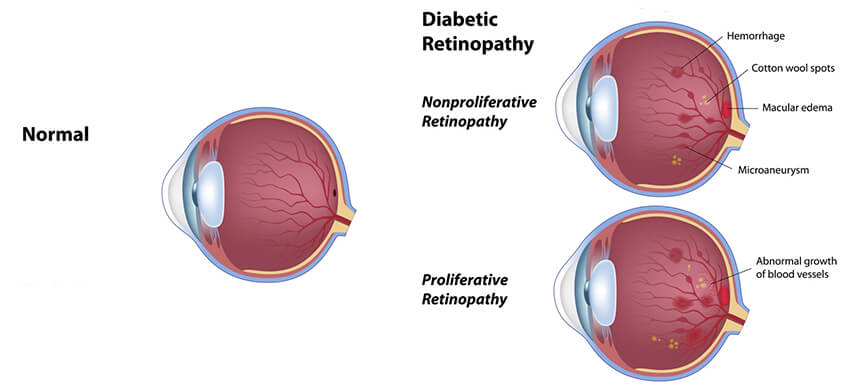The retina allows your eye to “see”. It is the light- sensing structure that lines the back of the eye; it is responsible for translating that light into signals your brain can understand as images. If you think of your eye as a “camera”, the retina is the “film”.
There are many ocular and systemic diseases that can affect the retina. Many of these diseases can be diagnosed and treated by the physicians at North Idaho Eye.
Here is a brief summary of some of the more common retinal diseases we diagnose and treat:
Diabetic Retinopathy
Diabetes is the leading cause of blindness in working age Americans. Retinopathy (eye disease caused by diabetes) can present in both Type 1 and Type 2 diabetes, and early detection is important to maintaining good vision and preventing vision loss. Yearly comprehensive exams are recommended (at the time of diagnosis in Type 2, and 5 years after diagnosis in Type 1). If treatment is needed, the doctors and surgeons at North Idaho Eye are experienced with all the current treatment options.
Age-Related Macular Degeneration (ARMD)
ARMD is the leading cause of visual loss in patients over 50 years old. People with ARMD experience deterioration or “degeneration” in an area of the central retina called the macula. This degeneration usually occurs slowly over many years, but in its more severe forms, can lead to significant loss of central vision. Symptoms of ARMD may include blurry vision, loss of vision, a blurry spot in your central vision, or distortion in your vision. Risk Factors include smoking, family history, Caucasian race, high blood pressure, and high cholesterol. The doctors at North Idaho Eye are trained to detect the early signs of ARMD as well as treat its more severe forms.
Retinal Vein Occlusions
Retinal vein occlusions occur when a retinal vein becomes occluded (usually by the combination of a hardened artery and/ or a blood clot) and the fluid and blood in that vein back up into the eye causing loss of vision. Most people complain of sudden blurriness in part or all of their vision in one eye. The amount of visual loss is determined in part by whether the blockage is in a smaller “branch” vein (BRVO) or in the main “central” vein draining the eye (CRVO). These usually occur in patients over 50 years old who typically have hypertension. Diabetes and glaucoma can also increase your risk. There are several treatment options for vein occlusions and the Coeur d’Alene and Post Falls doctors at North Idaho Eye are expert in the application of these treatments.






